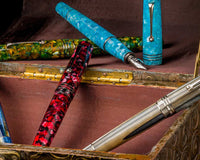Students are becoming more interested in fountain pens, and this has led to many resources that act as guides in choosing the right fountain pen for studying. However, there aren’t that many suggestions for fountain pen ink that is appropriate for use in classrooms.
There are several blue, black, red, and brown inks available that you can use for school. In fact, there are so many shades available that just browsing samples of blue inks alone may be daunting! Fortunately, we’ve narrowed that list down to some of the most dependable inks students can use.
What to look for in school-appropriate ink
Color. School-friendly ink colors typically include just two colors: black and blue. Fortunately, there are other fountain pen ink colors that are discreet enough for use in class, whether it’s a deep burgundy or a dark green. For this list, however, we’ll keep the colors as class-appropriate as possible.
Versatility. School-appropriate fountain pen ink should be versatile. Students should be able to use it on different types of paper and in different fountain pens. Whether they need to write notes, make annotations, draw and sketch, or even journal, having a versatile fountain pen ink is a must.
Ease of use. Students will want well-behaved ink. This means using ink that has a decent flow and lubrication without being too wet. It should have a fast-enough dry time to keep up with a lot of fast scribbling and note-taking without feathering or bleeding through regular paper. It is also good practice to use any of these inks with smaller fountain pen nibs such as fine or extra fine to prevent any issues.
With that, let’s get onto the inks themselves.
Platinum Carbon Black

Carbon Black is an excellent ink for students to start with. It is incredibly resistant to water and fading. It also doesn’t feather or bleed through regular copy paper. This makes it an ideal option for students who want to protect their notes from unexpected spills. The ink is made with small carbon pigment particles that adhere to the paper's surface and are nearly impossible to remove.
Great performance, however, also entails great responsibility. The same characteristics that make Carbon Black so dependable also make it difficult to clean out of a pen. While using Carbon Black, we advise cleaning your pen about every four weeks to keep it safe and writing at its best.
Waterman Serenity Blue

This relaxing, cool blue ink is renowned for working well with almost any pen and paper. When testing it with broad nibs on inexpensive printer paper, there was some feathering and traces of bleedthrough, so it’s best not to go past medium nibs when writing with this ink.
This is one of the best blue inks out there in terms of performance. And although Serenity Blue is not waterproof, it is easy to clean thanks to its high water solubility. A thorough flushing should remove all the debris, even if you forget to clean your pen for a long and the ink inside dries off. Students can also use Serenity Blue in practically any pen because it is available in bottles and standard international cartridges.
Diamine Denim

Although blue is a popular school ink, it's far more enjoyable to use a shade of blue that stands out without being too fancy. Diamine Denim is a deep blue ink that actually has a denim-like appearance. It's a blue ink with light gray undertones, subtle shading, and a medium flow. It dries relatively quickly as well. If your professor or teacher prefers to stay with the traditional blue or black ink, this one is nicely saturated, making it simple to read and ideal for exams and taking notes.
Pilot Iroshizuku Yama-Guri

If you’re looking for an ink that isn’t blue or black, then this Pilot fountain pen ink is worth a try. Yama-Guri has a lovely brown-black color with subtle hints of purple. It's useful for those who don't want to use ink that is completely black but still want to use something that is dark enough that nobody will notice. On inexpensive copy paper, this ink performs admirably. A little bit of feathering is present, but not enough to be distracting. For forms or other papers that call for black ink, this is a good alternative. It will produce very little shading and a color that is very close to black if you use a fine nib.
Diamine Salamander

Salamander is a complex color. It may appear as a combination of green, black, and brown. The color is difficult to describe, but it is very interesting and conservative enough for note-taking. This ink has a lot of shading, so if you’re uncomfortable with that, steer clear. The flow is moderate, but to be safe, try to use it with a dry writer to avoid feathering on ordinary paper.
Whether students are taking notes during lectures or studying with friends, having a dependable ink to go with their fountain pen is a must. And even if you aren’t a student, these options are great for everyday use.
Happy writing!
By Some Folks at EndlessPens






1 comment
Paul Herman
Should include iron gall ink, if you added Carbon Black. Modern iron gall ink is generally safe for everything (and you included Iroshizoku which was linked to eating vintage latex ink sacs) is permanent enough for the Magna Carta. It’s the ancestor and also a contemporary to modern blue-blacks, and it is possibly the best behaved ink for most types of paper (even school paper.)